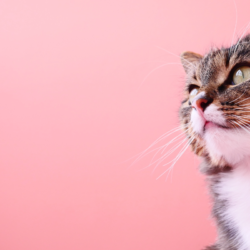Cat behaviour is captivating. Mysterious, they intrigue ethologists and cat lovers alike. These small carnivores express a rich range of body and sound signals. They navigate their world in complex and subtle ways. This article explores the diversity of feline behaviour. It is based on research and behavioural observations.
Kitten behavioural development
The kitten’s behavioural development encompasses the prenatal period and the first few weeks of life. These phases are crucial in shaping the kitten’s identity and can influence the appearance of developmental disorders, particularly forms of aggression. Understanding the feline lifestyle is essential to understanding these disorders.
During the gestation period of 59 to 63 days, the embryo is sensitive to maternal emotions and develops its sensory organs. It perceives caresses on its mother’s belly, which influences its development.
The neonatal period, until the eyes open (seventh to tenth day), is characterised by reflexes such as burying and suckling. Attachment is unilateral, from mother to kitten.
The transition period runs from the opening of the eyes to the acquisition of hearing (twentieth day) and marks the maturation of the sensory organs. Attachment becomes bilateral with recognition of the mother as a source of comfort.
From the second to the seventh/eighth week, this phase is crucial for learning and socialisation. Environmental stimuli influence the maturation of synapses and the establishment of social behaviour.
Socialisation
There are two types of socialisation: inter- and intraspecific.
Intraspecific socialisation represents the kitten’s identification with its own species. This process, compared to the imprinting described by Lorenz, takes place mainly through interactions with its mother and siblings. During this period, the kitten learns the communication codes specific to the feline species. Early exposure to other individuals of the species is generally enough to ensure adequate socialisation. A large litter size and keeping the siblings together until the eighth to tenth week will help to ensure optimal socialisation. Inadequate socialisation to its own species can lead to behavioural problems, such as fear or aggression towards conspecifics.
Unlike intraspecific socialisation, interspecific socialisation involves recognising “friendly species”. This phase is more complex, requiring encounters in a favourable environment and subsequent reminders. Contacts must be positive and repeated, in the presence of a calm mother. Insufficient socialisation with other species can lead to aggressive reactions out of fear or to predatory behaviour.
Sensory homeostasis threshold
Sensory homeostasis refers to an individual’s emotional stability in the face of variations in their environment. During the sensitive period, the nervous system retains only the stimulated connections. The others disappear forever. So stimulating each sense is crucial. This helps the kitten to define its sensory homeostasis threshold. This threshold will influence how he reacts to stimuli in his environment.
Acquiring this sensory level requires active interaction with the environment. Studies have shown that kittens deprived of interaction with their environment, despite being placed in a normal visual environment, develop sensory deficits. The mother’s crucial role in this learning process is undeniable. She provides a safe environment that allows the kitten to explore its world without fear, while regulating its motor activity for effective exploration.
A high sensory homeostasis threshold guarantees successful adaptation to the future environment, preventing the appearance of phobias or aggression out of fear. It is also crucial to ensure that the kitten’s developmental environment is appropriate to its future living environment. An insufficiently stimulating environment can lead to difficulties in adapting to a more stimulating environment, while an environment that is too rich in stimuli can lead to anxious and aggressive behaviour.
Acquiring self-control
Learning
Kittens develop their experience and behaviour by interacting with their environment, their mother and their siblings, through various types of learning.
- Learning by association: Inspired by Pavlov’s work, this classic form of conditioning shows how the cat associates two stimuli with a state and then links one of these stimuli to that state. For example, a cat that feels fear or pain in the presence of a particular stimulus may associate this discomfort with the stimulus and subsequently display aggression out of fear.
- Instrumental learning: Skinner’s theory forms the basis of operant conditioning, which explains how consequences reinforce behaviour. For example, “tiger syndrome” can positively reinforce aggression. This enables the cat to escape an unpleasant stimulus more quickly or to acquire food.
- Imitation learning: This type of learning involves reproducing observed behaviour. Kittens can learn by imitating their mother or other animals. For example, kittens raised with dogs may adopt canine behaviours, such as lifting their paw to urinate. Similarly, kittens who observe their mother solving problems may find similar solutions more quickly.
These learning mechanisms are crucial for kittens. They shape future behaviour, including early hunting and toilet training. The mother is an essential role model for the kittens. However, kittens raised by an aggressive mother tend to be more aggressive. This suggests that aggression is learned by imitation.
Notions of attachment and detachment
Territory attachment and maternal detachment are fundamental stages in the kitten’s behavioural development.
Initially, attachment is unilateral, from the mother to her kittens, then becomes bilateral as soon as the kittens are able to recognise their mother. This bond is essential for the kitten’s cognitive and social development.
Maternal detachment, marking the end of behavioural development, in turn enables attachment to the territory. This process may be abrupt, with the mother chasing her kittens away, often starting as early as the fourth week when food weaning begins, or later and progressively around the twelfth or fourteenth week. Several factors influence the timing of detachment, such as the primiparity or maturity of the mother, an early return to heat, a large litter, or the presence of hostile adult cats. Female kittens are generally tolerated longer than males within the litter, while conditions such as late food weaning or a single kitten delay detachment.
These processes are crucial to the kitten’s adaptation to its environment and influence its ability to develop lasting bonds with its territory and other congeners.
Deciphering feline communication
Communication in cats is based around the four usual sensory channels: acoustic, visual, olfactory and tactile. With a range of audible frequencies from 20 to 100,000 Hertz, cats perceive a wide spectrum of sounds. However, the kitten’s vocal repertoire is initially limited, and it takes around six to eight months for it to master all the vocalizations specific to its species.
Types of vocalizations include purring, meowing (associated with reproduction), calling (expressing an intense emotional state), growling, hissing (continuous emission of air with the mouth open) and teeth chattering. Although cats use these vocalizations to interact with each other, their meaning often remains mysterious, especially in the case of purring. Cats may purr at pleasant times, such as during petting or nursing. However, purring can also occur in situations of stress or pain.
Mimics and postures
As hunters, cats have a well-developed visual sense, sensitive to contrasts and movements. Its visual perception remains effective even in low light, enabling it to see as clearly as a human with up to six times less light. In the absence of light, cats guide themselves mainly by touch, using their vibrissae in particular.
Cats have a rich repertoire of gestures, including facial mimics and body postures. Ear movements and variations in pupil diameter are important indicators of a cat’s emotional state. Recognising these subtle signs is essential to understanding their emotions and anticipating aggressive behaviour.
Games, which are essential during the socialisation period, help cats to learn postures and communication rituals. These social games begin around the third or fifth week and last until the twelfth or fourteenth week, and include various postures such as belly-up, stand-up, side-step, stalking, rearing and confrontation. Individual play, on the other hand, begins around the seventh week and persists into adulthood, being dominated by predatory behaviour.
In attack and defence situations, the cat’s postures vary. In the offensive position, the cat’s back is arched, its limbs tense, its tail stiff, and it may emit vocalisations such as the “feulement”. In the defensive position, the cat is crouching or lying down, with its ears pressed to its sides and its eyes miosis or mydriasis. Certain postures can also be mixed, combining offensive and defensive elements. These aggressive postures serve as a basis for describing the cat’s aggressive behaviour in different situations.
Pheromones and markings
Cats have 67 million olfactory cells covering 20 cm². Their olfactory capacities surpass those of humans, although they are still inferior to those of dogs. They use olfaction for communication, notably via pheromones. The vomeronasal organ plays a central role in this process. Located in the nasal cavity, it contains nerve and hair cells. It connects to the accessory olfactory bulb and the limbic system, but not to the cortex. As a result, its perception is less precise than that of the main olfactory system.
Pheromones, volatile substances emitted by one individual and perceived by another of the same species, induce specific reactions. They are detected only by the vomeronasal organ, thanks to the flehmen behaviour that transports air to this organ. The pheromones are transported through a layer of mucus to reach the receptors, thanks to binding proteins.
The production of pheromones involves various glands in the body, such as the jugal, perioral and podal glands and the perianal complex. Each gland contributes to chemical communication. Cats mark their territory and situations using specific methods: facial marking, urinary marking, scratching and alarm marking. Facial pheromones (F2, F3, F4) play a key role in facial marking, affecting cats’ social interactions and emotional states.
Notion of territories
The cat, a territorial animal, structures its space into specific zones, marked by visual signs (such as urine spots and scratching) and/or olfactory signs (pheromones), each with a specific function.
- Activity fields: These zones encompass all the cat’s activities, including play, predation and social interaction, which may be shared by several cats. Outdoors, these areas are often demarcated by urine marking, a less common practice with indoor cats.
- Isolation field: Area dedicated to rest and refuge, generally located high up and out of the way, marked by scratching to indicate an unshared space. A cat can have several of these fields.
- Elimination field: Personal field for elimination, located in a quiet area and marked by scratching, with a soft floor to encourage this activity.
- Aggression field: Defines the space which provokes the cat’saggression if penetrated by an intruder, its size varying according to the cat’semotional state. This field is not specifically marked, reflecting the variable nature of the cat’s defensive reactions.
Understanding these zones makes it possible to prevent aggressive behaviour, by respecting the cat’spersonal space and shared areas, while avoiding overpopulation in confined spaces to limit intraspecific aggression.
Predation
Predation is a normal behaviour in the cat’s repertoire, distinct from aggressive reactions in terms of the stimuli, postures, integrating mechanisms and neurotransmitters involved. However, it can become problematic when it targets inappropriate prey such as a child or another domestic animal. This behaviour can be broken down into three main phases.
- Appetitive phase: The mere sight or sound of prey can activate predatory behaviour, regardless of hunger. Depending on the proximity of the prey, the cat adopts an approach – moving cautiously towards its target before coming to a halt – or a stalking posture, where it remains crouched and ready to pounce, keeping its body close to the ground.
- Consumption phase: The cat pounces, seizes the prey with its claws and bites with aquiet, unemotional bite, in contrast to the emotionally charged bites of aggressive behaviour.
- Stopping phase: After capturing its prey, the cat may eat it or, more often, leave it dead. This behaviour illustrates that the cat is hunting to hunt, not necessarily to feed.
Relationship to food
Cats are natural nibblers, eating ten to twenty small meals a day, consuming ten to twenty grams per meal. Two meals a day are not enough to meet the cat’s natural needs. Self-service feeding is therefore preferable. However, this method is suitable for an active cat that has not been sterilised, as long as its weight is monitored regularly. For a sterilised or indoor cat, this approach increases the risk of overweight and is therefore not recommended.
After sterilisation, a cat’s energy requirements drop byaround 20%. They may lose their ability to regulate their food intake naturally. It is crucial to offer a controlled quantity of food, adjusted to the animal’s energy requirements, but leaving access free to respect its natural eating rhythm.
The different types of aggressive disorder
Behavioural disorders in domestic felines, particularly aggression, are a significant problem for both the animals and their owners. Aggression in cats can take a variety of forms. It can be triggered by a multitude of environmental, physiological and psychological factors.
Predatory behaviour
Predatory behaviour is natural in cats. It is not an aggressive disorder. However, without good interspecific socialisation, it can become problematic. The cat could attack other domestic animals. It could also attack unrecognised humans. This includes babies, four-legged children and elderly people with walking sticks. Faced with this situation, intervention is necessary despite the poor prospects of recovery. Only broad interspecific socialisation can prevent these behaviours. It should be noted that certain aggressive predation-related disorders occur in stressful situations or during tiger syndrome, but will not be detailed here to avoid any confusion with normal predatory behaviour. The domestic cat remains an innate predator, which can sometimes prove problematic for its owner.
Play-related aggression
Aggression linked to anxiety in a confined environment and that associated with inappropriate play behaviour manifest themselves differently but share common roots linked to stress and poor upbringing.
Confined environment anxiety is defined by intermittent, predominantly crepuscular aggression targeting the owners’ extremities. This condition emerges in hypo-stimulating environments, where the lack of activity leads the cat to direct its boredom and hunting instinct towards its owners. Cats deprived of outdoor access or adequate stimulation are particularly at risk. Replacing natural hunting with adapted games can reduce this anxiety.
As foraggression during play, this is the result of inadequate play training, where the cat does not control its strength, clawing and biting excessively. This is often observed in kittens without a regulating adult figure, brought up too permissively by their owners. This form of aggression can worsen into HSHA syndrome, marked by a loss of control over all behaviours, making the prognosis rather bleak.
Territorial disorder
Territorial aggression andcohabitation anxiety are two forms of behaviour in cats that require a clear distinction for better understanding.
Territorial aggression is provoked by the unauthorised intrusion of an “intruder” into the cat’s territory, with a prevalence in males defending a larger territory than females. This aggression can also be triggered by changes in the domestic environment, such as the arrival of a new person or animal. The behavioural sequence includes offensive and defensive postures, leading to an attack if the intruder does not retreat, and ending with a drive away from the territory.
Cohabitation anxiety is triggered by territorial disputes between cats. This often happens when a new cat arrives or if the hierarchy changes. Fights break out, which is normal. But if the owner acts badly, this can make the situation worse. His intervention can block the creation of new territorial rules, thus increasing the cats’ anxiety. Three stages have been identified, ranging from distancing toobnubilation, with increasing consequences for the cats’ well-being.
Aggression through irritation
Petting-biting syndrome
Contact intolerance aggression, also known as ” petting-biting” syndrome, describes irritant aggression when a cat is petted. Initially, the cat seems to enjoy being stroked, but may suddenly bite or scratch. There are several hypotheses to explain this behaviour, including a tolerance threshold for tactile stimulation that has been exceeded, a startle reaction on awakening, or a signal to stop contact that has become undesirable. The owner often fails to detect the discreet warning signs of aggression, such as slight tail movements or a change in eye expression. If contact continues despite these warnings, the animal goes on the attack. This aggression serves to free the cat from the contact, reinforcing the aggressive behaviour as a means of escape. This syndrome illustrates the importance of recognising and respecting the cat’s comfort limits during physical interactions.
Tiger syndrome
Hunger-related aggression, also known as “tiger syndrome”, is characterised by predatory aggression during twilight hours and aggression due to irritation during meal preparation. This syndrome results from a food distribution rhythm that is unsuited to the cat’s nibbling nature, preferring to eat small quantities frequently rather than settle for two large meals. As a result, impatient and hungry cats can become aggressive towards their owners when fed. Aggression is similar to that caused by anxiety in a confined environment. They include reactions of irritation and excitement during meal preparation. The prognosis is good. A well-managed self-service feeding system often resolves these problems.
Fear-related aggression
Fear aggression is manifested by violent reactions in cats when they find themselves in a situation perceived as threatening, with no possibility of escape. Cats with a history of phobias, deprivation syndrome oranxiety are more susceptible to this type of aggression. However, even a well-socialised cat can react aggressively out of fear to an aversive event.
During the threat phase, the cat shows neurovegetative signs such as salivation, mydriasis and vocalisations, adopting a defensive posture characterised by a lateral decubitus position and ears laid back. If the stress persists, the resulting attack is violent and uncontrolled, often leading to deep wounds. Following the attack, the cat tries to retreat.
The prognosis differs. It is good for a well-socialised cat that reacts to a specific stimulus. For cats with serious behavioural problems, the prognosis is guarded. A worrying development would be fear that spreads to various stimuli that are difficult to recognise. Or aggression becoming a means of escape.
Redirected aggression
Redirected aggression occurs when a cat attacks a target by substitution. This happens when the real stimulus, visual, auditory or olfactory, is inaccessible. For example, a cat that cannot reach another animal behind glass will instead attack a nearby target, such as its owner. This type of aggression, common in adult males, includes territorial or fear-related conflicts between males.
Owners may find sudden aggression disconcerting, especially as there may be a long delay between the initial stimulus and the attack. It is crucial to recognise the early signs of agitation and hypervigilance to avoid initiating risky contact. After an attack, or in the absence of a target, the cat may calm down and resume normal activities, signalling that safe contact is once again possible.
Hormonal status
Aggression linked to hormonal status encompasses two main manifestations:aggression between males andmaternal aggression.
Male-to-male aggression often occurs in the presence of a female in oestrus, involving behaviour ranging from intimidation to actual fighting. The males adopt specific aggressive postures, glaring at each other and vocalizing intensely, which can evolve into direct confrontation if neither backs down.
Maternal aggression is characterised by the defensive reactions of mother cats aimed at protecting their litter from possible danger. Unlike males, who may attack kittens, females are mainly threatening, adopting a “defensive-offensive” posture. This behaviour is directly linked to the hormonal status of the lactating female and generally disappears when the kittens are weaned.
Dysthymia
Aggression and dysthymia in cats result in mood disorders. They alternate between “hyper” phases of hyperactivity and irritability, and “hypo ” phases of depression. Several factors can cause dysthymia. These include hormonal imbalances, developmental disorders, emotional problems and brain damage. The Abyssinian breed appears to be more predisposed to these disorders. The pathogenesis suggests hyperexcitability of the nuclei of the limbic system.
Clinically, dysthymia manifests itself in two forms: unipolar, alternating hyperactivity and normality without a depressive phase, and bipolar, with cycles of hyperactivity and depression. The ‘hyper’ phases are characterised by intense agitation, impulsivity and increased aggression, while the ‘hypo ‘ phases reflect depressive symptoms. The onset of attacks can be signalled by a “crazy look”, marked by intense mydriasis.
Instrumentalised aggression
Instrumental aggression describes a situation where the cat uses aggression to escape a constraint or an unpleasant situation. Each success reinforces the aggressive behaviour. This phenomenon is not linked to any specific breed, sex or age.
The typical behavioural sequence of aggression is divided into three phases: “appetitive” (threat), “consummatory” (scratching and biting), and “appeasement” (end of attack). When an aversive stimulus is regularly neutralised by aggression, the cat associates the latter with the cessation of discomfort. In this way, stimulus avoidance becomes a reinforcer, solidifying learning via operant conditioning.
Gradually, theappeasement phase shortens until it disappears, eliminating the “stop signal”. The absence of this phase allows the attacks to continue. Subsequently, the “appetitive ” phase also diminishes, leaving the bite as the only reaction. Eventually, the behavioural sequence is completely altered, with no regulation, and the behaviour becomes “rigid”.
Other types
A cat’s behavioural response is influenced by its genetic make-up, its environment and its experiences. Although some breeds, such as Siamese, Burmese and Abyssinians, have specific behavioural predispositions, it is crucial to consider that the environment, care and interaction with humans modulate these traits. Only 10% of cats have a pedigree, leaving the vast majority of European cats with no precise racial classification. Nevertheless, studies of European cat colonies reveal three main temperaments: suspicious, sociable and balanced, identifiable from the very first weeks of life.
Furthermore,idiopathic aggression is defined as a form of aggression with no identifiable cause, after excluding other factors. It is a diagnosis of exclusion, subject to debate among experts. Some cases of aggression, such asfear or redirectedaggression, can make it difficult to identify the triggering stimulus, making diagnosis long and arduous. Before concluding that aggression is idiopathic, a thorough clinical and behavioural examination is required, underlining the importance of rigorous and repeated assessment.







